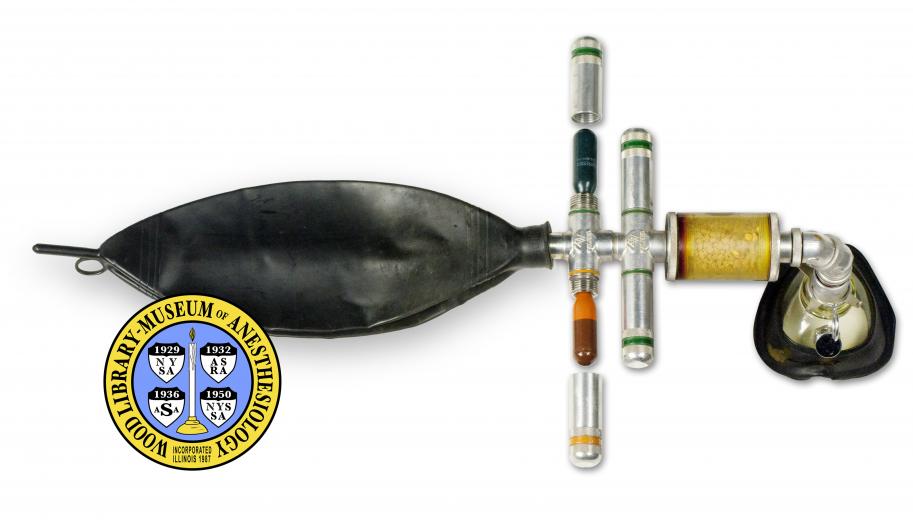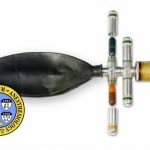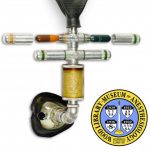Hingson Field Unit
In the early 1950s, Dr. Robert A. Hingson (1913-1996) became chairman of the Anesthesiology Department at Case Western Reserve University. Shortly thereafter he developed this field unit with engineers Frank Ziherl and Arthur Kish. Their objective was to create a safe, portable and simple device that could be used for resuscitation and administration of anesthetic gas mixtures with oxygen. They developed a nonexplosive gas mixture of 40% cyclopropane (the anesthetic), 30% helium and 30% oxygen, and packaged six liters of it into two miniature gas cylinders, each less than 3 inches long. The small gas cylinders and carbon dioxide (CO2) absorber made the device light and easy to carry.
The device was recommended for procedures of short duration, including dental and outpatient procedures. The unit could also be used as a resuscitator by fitting it with cylinders of oxygen alone. The device was known by many different names, including the Cyclopropane-Helium-Oxygen Emergency Field Anesthesia Unit, Western Reserve Portable Anesthesia Machine, and the Western Reserve Miniature Anesthesia Machine and Oxygen Resuscitator.
Dr. Hingson might be best known for introducing caudal and epidural anesthesia into the practice of obstetrical anesthesia. He was also a trail-blazing humanitarian, and founded the Brothers' Brother Foundation. The finding aid to the Robert A. Hingson Collection can be accessed from the Archives section of the Wood Library-Museum website, under Individual Collections.
Catalog Record: Hingson Field Unit
Access Key: ailf
Accession No.: 1991-06-21-1 A
Title: [Hingson cyclopropane-helium-oxygen emergency field anesthesia unit / designed by Robert A. Hingson, Frank A. Ziherl, and Arthur S. Kish].
Author: Hingson, Robert A. (Robert Andrew), 1913-1996.
Title variation: Alt Title
Title: Western Reserve miniature anesthesia machine and oxygen resuscitator.
Title variation: Alt Title
Title: Western Reserve portable anesthesia machine.
Title variation: Alt Title
Title: Portable Hingson cyclopropane-helium-oxygen gas machine.
Title variation: Alt Title
Title: Western Reserve portable anesthesia machine, resuscitator and oxygen
inhalator.
Title variation: Alt Title
Title: Hingson cyclopropane-helium-oxygen emergency field anesthesia unit.
Title variation: Alt Title
Title: Western Reserve midget.
Title variation: Alt Title
Title: Hingson’s apparatus.
Title variation: Alt Title
Title: Hingson’s Western Reserve unit.
Publisher: [Wickliffe, Ohio] : Z. & W. Inc., [1955-1980].
Physical Description: 1 anesthesia apparatus : metal, rubber, plastic, aluminum ; 70 x 11.5 x 27 cm.
Subject: Anesthesia, Inhalation.
Subject: Cyclopropanes.
Subject: Oxygen.
Subject: Helium.
Subject: Resuscitation.
Note Type: General
Notes: Title taken from instructions donated with the apparatus; Alternate titles
were taken from Dr. Hingson’s articles and the patent.
Note Type: Citation
Notes: Hingson RA, Davis HS, Rosen M. The historical development of jet injection
and envisioned uses in mass immunization and mass therapy based upon two
decades of experience. Mil Med. 1963;128(6):516-524.
Note Type: Citation
Notes: Hingson RA. New portable anesthetic gas machine and resuscitator: preliminary
report. JAMA. 1954;156(6):604-606.
Note Type: Citation
Notes: Hingson RA. The Western Reserve portable anesthesia machine, resuscitator and
oxygen inhalator as the vehicle for nonexplosive cyclopropane-helium-oxygen
anesthesia. In: International Anesthesia Research Society, Ed. Proceedings:
World Congress of Anesthesiologists, Scheveningen, The Netherlands, September
5-10, 1955. Minneapolis, Minn.: Burgess Publishing Co., 1956:150-152.
Note Type: Citation
Notes: Mushin WW, Thompson PW. Cyclopropane in non-explosive mixture for out-patient
anaesthesia. BMJ. June 14, 1958;1(5084):1376-1378.
Note Type: Citation
Notes: Rosenberg H, Axelrod JK. Robert Andrew Hingson: his unique contributions to
world health as well as to anesthesiology. Bul Anesth Hist. 1998;16(3):10-12.
Note Type: Citation
Notes: Ziherl FA, Kish AS, Hingson RA, inventors; Z and W Machine Products, Inc.,
assignee. Portable anesthesia machine, oxygen inhalator and resuscitator. US
patent 2,944,547. July 12, 1960.
Note Type: Physical Description
Notes: The apparatus consists of an oronasal mask, carbon-dioxide (CO2) absorber,
four ports for miniature gas cylinders, and a reservoir bag; The length of 70
cm is from the tip of the mask to the end of the bag; The mask consists of
black rubber, transparent-plastic, and metal, and measures approx. 12 x 11.5
x 6.5 cm; An expiratory-valve protrudes from the mouth end of the mask; A
spring-valve connects the mask to the tubing that leads to the absorber;
Pressure on the mask opens the spring-valve and allows for the inhalation of
gas; The valve can be set in the open position by a clip; The metal tubing
that connects the mask to the CO2 absorber is made up of multiple pieces and
when viewed upright, curves 90 degrees downward; Manufacturer’s marks are on
two of these pieces: “Z & W”; The canister of the soda-lime, CO2 absorber
consists of metal and transparent plastic, and measures approx. 10 x 5.5 dia.
cm; A partially torn sticker on the canister has manufacturer’s markings:
“CHI” in large lettering, and “Cleveland, Ohio” in smaller lettering below
the “CHI”, surrounded by “Continental Hosp…. [tear in sticker] …ustries Inc”
[possibly “Continental Hospital Industries”]; Between the canister and the
reservoir bag are two tubular connections that each have two aluminum sleeves
and pin-ports for miniature gas cylinders; “Z & W” is marked on one side of
each tubular connection; The sleeves hold the cylinders perpendicular to the
tubing; Each of the four miniature gas-cylinders are approx. 6.5 x 1.5 dia
cm; The sleeves are approx. 7.5 x 2 dia. cm; The reservoir bag is made of
black rubber and has worn manufacturer’s markings where it connects to the
metal tubing, possibly from Ohio Medical Products.
Note Type: Reproduction
Notes: Photographed by Mr. William Lyle, 7/15/2010.
Note Type: Acquisition
Notes: Donated to the WLM by Robert Kroll, D.D.S., and Justin Stone, D.D.S., in 1991
Note Type: Historical
Notes: During the early 1950s, shortly after becoming chairman of the Anesthesiology
Department at Case Western Reserve University, Dr. Robert A. Hingson
(1913-1996) developed this field unit with engineers Frank Ziherl and Arthur
Kish. Their objective was to create a safe, portable and simple device that
could be used for resuscitation and administration of anesthetic gas mixtures
with oxygen. They developed a nonexplosive gas mixture of 40% cyclopropane
(the anesthetic), 30% helium and 30% oxygen, and packaged six liters of it
into two miniature gas cylinders, each less than 3 inches long. The small gas
cylinders and carbon dioxide (CO2) absorber made the device light and easy to
carry. Hingson and others recommended that the device be used for procedures
of short duration, including dental and outpatient procedures. The unit could
also be used as a resuscitator by fitting it with cylinders of oxygen alone.
The device was known by many different names, including the
Cyclopropane-Helium-Oxygen Emergency Field Anesthesia Unit, Western Reserve
Portable Anesthesia Machine, and the Western Reserve Miniature Anesthesia
Machine and Oxygen Resuscitator.
Note Type: Historical
Notes: Dr. Hingson might be best known for introducing caudal and epidural
anesthesia into the practice of obstetrical anesthesia. He was also a
trail-blazing humanitarian, and founded the Brothers’ Brother Foundation. The
finding aid to the Robert A. Hingson Collection can be accessed from the
Archives section of the WLM website, under Individual Collections. at
https://www.woodlibrarymuseum.org/archives_items.php?id=11.
Note Type: Publication
Notes: Hingson FA. The Western Reserve anesthesia machine, oxygen inhalator, and
resuscitator. J Am Med Assoc. 1958;167(9):1077-1082.
Note Type: Publication
Notes: Mushin WW, Thompson PW. Cyclopropane in non-explosive mixture for out-patient
anaesthesia. Brit Med J. 1958;1(5084):1376–1378.



